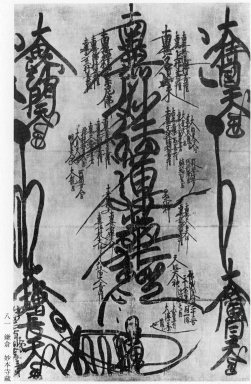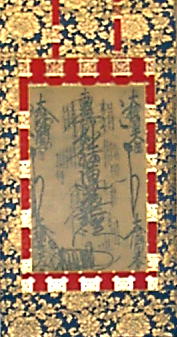The Buddhas
Two Buddhas are shown on the Omandala,
Shakyamuni Buddha and Many-Treasures Tathagata, but there are
other buddhas who are present at the Ceremony in the Air.
Also present are the Emanation Buddhas of the Worlds of the
Ten Directions. This last group is compromised of all the
buddhas of the pure lands throughout the universe who are in
actuality the emanations of the Original Shakyamuni Buddha.
These buddhas are not shown on the Shutei Mandala, but their
presence is implied. Altogether, Shakyamuni Buddha and the
Emanation Buddhas show the unity of all the buddhas in all
directions with the Odaimoku.
Since the Omandala shows all the sentient beings of
the ten worlds illuminated by the Odaimoku, the
representatives of the other nine worlds on the Omandala are
the buddhas of the future. In that sense, Shakyamuni Buddha
and his emanations represent the buddhas of the present,
Many-Treasures Tathagata represents all the buddhas of the
past, and the other sentient beings are the buddhas of the
future. This shows the unity of all the buddhas in all times
with the Odaimoku.
Namu Shakamuni Butsu
(Shakyamuni Buddha)
On the Great Mandala, Shakyamuni Buddha is the Original
Buddha who can not be spoken or thought of in terms of birth and death, self or
other and is the source of all other manifestations of
buddhahood. He is the Eternal Shakyamuni Buddha who is unborn and
undying.
In the sutras prior to the Lotus Sutra, Shakyamuni
Buddha is the historical Buddha who attained enlightenment
about 2,500 years ago and taught the way to enlightenment to
others for approximately 50 years in northeastern India until
his death at the age of 80. This view does not change until
the 11th chapter of the Lotus Sutra. In that chapter,
Many-Treasures Tathagata appears in his stupa of treasures
and testifies to the veracity and excellence of the One
Vehicle teaching which Shakyamuni Buddha expounded in the
first 10 chapters of the sutra. The assembly then ask to see
Many-Treasures Tathagata, but in order to open the stupa of
treasures Shakyamuni Buddha must recall his many emanations
who are the buddhas of the ten directions. Shakyamuni Buddha
purifies the world three times and then recalls his
emanations. In doing this, he is no longer merely the
historical Buddha but the source of all the ideal buddhas of
the pure lands throughout the universe. He then opens the
stupa of treasures, joins Many-Treasures Tathagata in the
stupa which is already floating in the sky, and then uses his
supernatural power to enable the entire assembly to rise up
into the air as well. This is the beginning of the ceremony
in the air. In chapter 15, Shakyamuni Buddha summons forth
the bodhisattvas who emerge from beneath the earth and
reveals that they are his original disciples from the remote
past. In response to the question of how he could have taught
these innumerable bodhisattvas beginning in the remote past
when he has only been teaching for the past forty years, the
Buddha reveals in chapter 16 that he did not attain
enlightenment for the first time beneath the Bodhi Tree forty
years before the events in the Lotus Sutra. Rather, he
attained enlightenment in the unquanitifiably remote past. It
is in chapter 16 that Shakyamuni Buddha shows himself as the
Eternal or Original Buddha and not simply the historical
buddha or even merely the source of the emanated buddhas of
the present. It is this view of Shakyamuni Buddha in the 16th
chapter which is the key to the true nature of enlightenment
according to Nichiren Buddhism.
Shinjo Suguro explains that the original and eternal Shakyamuni
Buddha provides Buddhism with a united faith:
In Buddhism, various Buddhas have been established
as objects of devotion for different pious believers. Since
each Buddha has a good reason for being venerated, Buddhism
permits us to worship any or all of them. Nevertheless, the
Most-Venerable-One should be One, just as the Truth is One.
The second half of the Lotus Sutra (Hommon) emphasizes such a
Buddhist position regarding the unity of faith. As the object
of faith is absolute, it must relate to the realm of
eternity. Generally we think of Sakyamuni as a historical
figure, bound by the limitations of time and space, and only
a provisional manifestation of the infinite, eternal Buddha.
According to the Lotus Sutra, however, every Buddha,
including the historical Sakyamuni Buddha, is a
representation of the eternal original being of Sakyamuni.
Sakyamuni, when seen as the eternal being, is called
the Original Buddha (Hombutsu), who was enlightened
in the remotest past. The other Buddhas are called 'manifestations
of the Buddha." The existence of each of them is a
provisional manifestation in some time or place of the
Original Buddha. The second half of the Lotus Sutra (Hommon)
reveals the concept of the eternity of Sakyamuni, in contrast
with the historical Buddha, who is a temporal representation
of himself.
(Introduction to the Lotus Sutra, p. 223)
The Original Shakyamuni Buddha represents the unity
of all three bodies (Trikaya) of a Buddha which are the
Dharma-body (Dharmakaya), the Bliss-body (Sambhogakaya) and
the Manifested-body (Nirmanakaya). The Original Shakyamuni
Buddha is distinguished from the historical Shakyamuni Buddha
by the presence of the Four Bodhisattvas who are the leaders
of the Bodhisattvas of the Earth. The historical Shakyamuni
Buddha, however, is only accompanied by his monk disciples,
such as Ananda and Mahakashyapa and only represents the
Manifestation-body. The more exalted Shakyamuni Buddha of the
provisional Mahayana teachings is accompanied by such
bodhisattvas as Manjushri Bodhisattva and Samantabhadra Bodhisattva, but only represents the Bliss-body perceived by the advanced bodhisattvas. Only the Original Shakayamuni
Buddha accompanied by the Four Bodhisattvas represents all
three bodies at once, all the other buddhas are merely
emanations or aspects of this Buddha. For this reason the
Original Shakyamuni Buddha is considered to be the Buddha who
is most worthy of reverence.
The Original Shakyamuni Buddha also displays the
three virtues of parent, teacher and sovereign of all who
live in this Saha-world. Which is to say, the Original Buddha
nourishes, teaches, and protects humanity through the power
of the Wonderful Dharma. This is because faith in the Lotus
Sutra enables our wisdom to mature, opens our eyes to the truth,
and frees us of suffering.
The pure land of the Original Shakyamuni Buddha is
the true reality of this world where the Buddha is always
present preaching the Dharma. As such, it is sometimes called
the Pure Land of Eagle Peak. In the Sutra of Meditation on
Samantabhadra Bodhisattva this pure land is called the Pure Land of Tranquil Light.
Icon: Buddha seated in meditation with hands in gassho. His
body aureoles contains three jewels.
Namu Taho Nyorai
Prabhutaratna Tathagata ~ Many Treasures Thus Come One
Many-Treasures Tathagata appears within the stupa of
treasures which emerges from beneath the earth and
ascends into the sky above Vulture Peak in the 11th chapter
of the Lotus Sutra. In that chapter he testifies to the truth
of what Shakyamuni Buddha has been preaching. Shakyamuni
Buddha then tells the congregation that the Many-Treasures
Tathagata taught in the world Treasure-Purity many ages ago,
and that he made a vow even after his extinction he would
appear to testify to the truth of the Lotus Sutra if anyone
should preach it after his passing. Many-Treasures Tathagata
also made a vow that he will allow the stupa to be opened and
his body revealed if the Buddha who preaches the Lotus Sutra
should recall all his emanated buddhas from throughout the
universe. This is in fact what Shakyamuni Buddha does, and
after all he has purified the Saha-world and recalled all his
emanations, he ascends into the sky, opens the sutra and, at
the invitation of Many-Treasures Tathagata, he enters the
stupa of treasures. Then Shakyamuni Buddha uses his
supernatural power to raise the entire congregation in the
sky as well. In this way, the ceremony in the air begins.
Senchu Murano points out that at first Shakyamuni Buddha is
the guest, but after he reveals his true status as the
Original Buddha he becomes the host and Many-Treasures
Tathagata becomes the guest of honor. Many-Treasures
Tathagata and his stupa return to their place of origin after
the general transmission of the Lotus Sutra in chapter 22,
though an offering is made to him and the stupa by
Avalokiteshvara Bodhisattva (Kuan Yin Bodhisattva) in chapter 25.
Many-Treasures Tathagata represents many things. On
one level, he represents all the buddha's of the past, and
his testimony shows that Shakyamuni Buddha's teachings are in
accord with the universal truth which is valid in all ages
and in all worlds. On another level, the Many-Treasures
Tathagata personifies objective reality while Shakyamuni
Buddha personifies subjective wisdom, so when they share the
seat within the stupa of treasures they are actually
demonstrating the unity of reality and wisdom, subject and
object. The emergence of the stupa of treasures itself and
the testimony of the Many-Treasures Tathagata from within it
could also indicate the emergence of Buddhahood from within
our own lives and our own inner recognition of and response to
the truth when we are able to hear it.
Icon: Buddha in meditation with hands in gassho. His body aureole contains a stupa.
|








